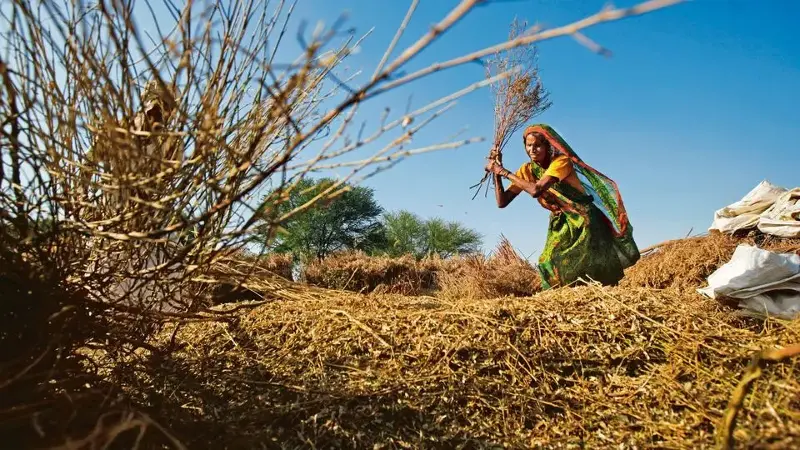
New Delhi: India’s kharif foodgrain output is expected to rise to 173.33 million tonnes in 2025-26, as plentiful monsoon rains boosted acreage and yields, the first advance estimates released by the Union agriculture ministry on Wednesday said.
The kharif output estimate is 3.87 million tonnes higher from last year. Rice production is expected at 124.50 million tonnes, up 1.73 million tonnes from the previous kharif season.
Maize output is projected to rise sharply by 3.49 million tonnes to 28.30 million tonnes, in a sign farmers are diversifying their crops to secure better prices amid strong demand from feed and starch industries.
Economists said that the increase in rice, maize and oilseeds output could ease supply pressures, and keep food inflation in check.
D.K. Joshi, chief economist at Crisil, said that the estimates were broadly in line with their expectations. “This has been a year of excess rain, but not all parts of the country were adversely affected. Other regions performed well, and overall we are doing reasonably well on agriculture,” he said. “The rabi outlook is also positive, so overall crop production should hold up.”
Coarse cereals production is pegged at 41.41 million tonnes, while kharif pulses are estimated at 7.41 million tonnes. Within pulses, tur production is expected at 3.59 million tonnes, urad at 1.20 million tonnes, and moong at 1.72 million tonnes.
Oilseed production is estimated at 27.56 million tonnes, led by groundnut at 11.09 million tonnes, which is 0.68 million tonnes more than last year. Soybean production is projected at 14.26 million tonnes. The higher oilseed numbers come at a time when edible oil inflation has moderated.
Later estimate
The first advance estimates have come out later than usual. The agriculture ministry typically releases the kharif projections in early November. In the release, agriculture minister Shivraj Singh Chouhan said that some regions reported crop losses due to excessive rainfall, while most areas benefited from a favourable monsoon that supported overall crop growth.
Sugarcane production is estimated at 475.61 million tonnes, up by 21 million tonnes, indicating a supportive cycle for crushing units in major producing states.
Cotton output is seen at 29.21 million bales of 170 kg each, almost unchanged from the 2024-25 level when production stood at 29.72 million bales. Industry officials say that the stagnant trend reflects reduced farmer enthusiasm for cotton, partly due to the government’s zero-duty import policy, which has weighed on domestic prices during peak arrivals.
The government has exempted customs duty on cotton imports till December-end.
Ganesh Nanote, a cotton farmer from the Vidarbha region in Maharashtra, said farmers had shifted a portion of their land to maize as cotton prices remained uncertain through the season. “Cotton hasn’t given steady returns for the last two years, and with the government allowing imports at zero duty, the rates fell further during peak arrivals,” said Nanote. “Many of us tried maize because the demand from feed mills is strong, and the crop is less risky in terms of input cost,” he said.
Essential for distribution scheme
A robust kharif production is seen as essential to meet the Centre’s continued free foodgrain distribution under the PM Garib Kalyan Anna Yojana. Under the scheme, the government provides additional 5 kg of free foodgrains every month to more than 80 crore beneficiaries under the National Food Security Act, and the Centre has extended the scheme to ensure continued support to low-income households.
Manish Daga, managing director of Cotton Guru, which helps farmers in the production process, said that India’s first advance estimates of 29.21 million bales of cotton output point to a below-normal cotton crop this year.
“In the near term, we expect tight availability of clean, ready-to-spin cotton, a firm basis for good grades, and higher dependence on imports to balance mill demand,” Daga said. “Lower-grade, rain-affected lots will continue to trade at discounts, so mills will likely rely on a mix of domestic and imported cotton, with parity shaped by the USD-INR trend, ocean freight and the pace of sales by Cotton Corporation of India (CCI).”
Daga said that the immediate priorities should include fast and transparent crop-loss audits at the state and district level to stabilise market expectations and prevent disorderly trading. “We also need to move from rejection to moisture management by publishing graded deduction slabs at APMCs and CCI centres, which will prevent distress sales and keep quality cotton flowing,” he said, adding that mills also need import policy clarity through March to secure affordable cover without facing stop-start volatility.
For the medium term, Daga said, “The focus should be on lifting yields through better seed choices, contamination control, nutrient and water management and integrated pest management.”
